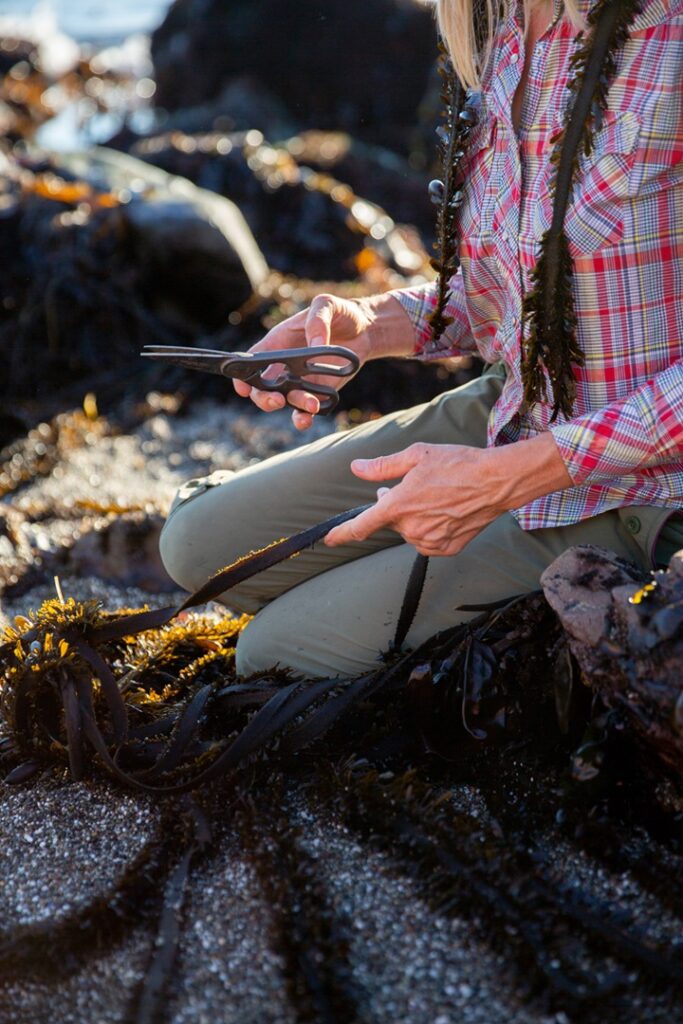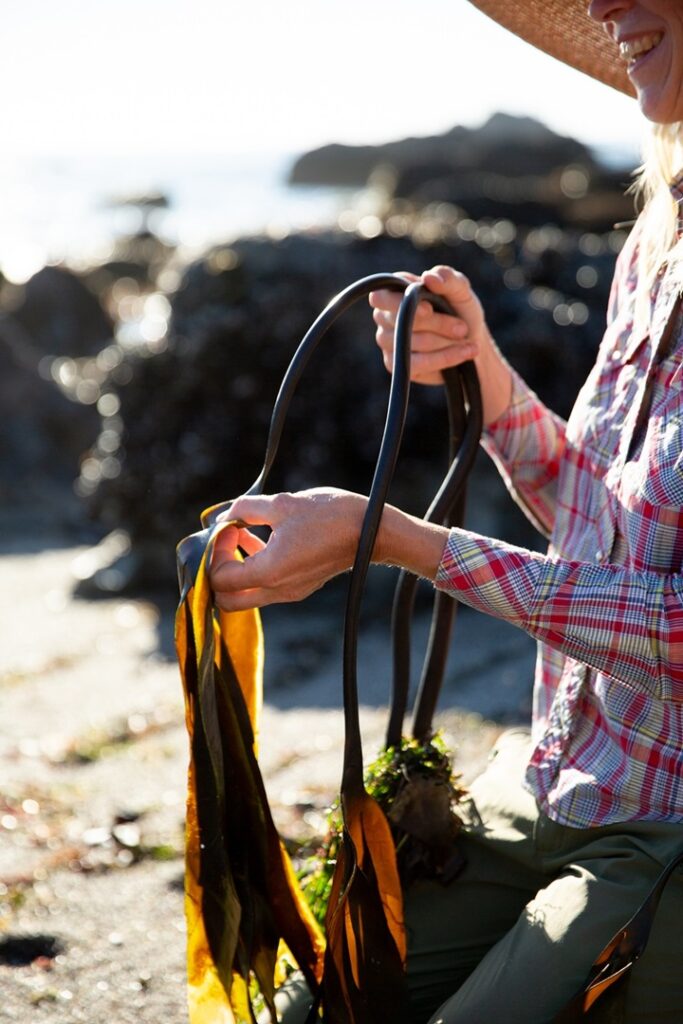Sea Change
Heidi Herrmann of Strong Arm Farm Dives into Seaweed Harvesting
PHOTOS BY PAIGE GREEN
The call of the sea is hard to resist, and Heidi Herrmann of Strong Arm Farm has both answered the call and continued the conversation.
Herrmann’s one-woman venture began as a typical vegetable-growing operation selling at farmers’ markets. But all that changed back in 2009. She was at the Occidental Farmers’ Market and thought she’d try something new.
“I put some seaweed I had casually collected with friends on the booth’s counter and it was very well received,” Herrmann recalls. “The excitement and buzz from customers and chefs who shopped there was very encouraging, and then, over the years, I began growing fewer vegetables and harvesting more seaweed.”
Indeed, over the last seven years, she has shifted away from vegetables entirely, growing and selling only cut flowers and rhubarb on her CCOF-certified organic farm. Now the biggest part of her business is the seaweed. Herrmann began harvesting the sea vegetable one early morning per year and is now up to about 15 mornings, collecting around 2,000 raw wet pounds over the summer season.

“I really enjoy selling to chefs and grocers—they appreciate high-quality, unique, local, flavorful foods that make their work shine. I invite my buyers to come harvest with me so they can partake in the process and see the origins of this ingredient,” she says.
Seaweed has many venerable health benefits. It purifies blood, alkalizes the body, and is high in calcium. A powerful antioxidant, it’s also rich in iodine, which the thyroid gland uses to boost the body’s metabolism. It’s a mineral and nutritional powerhouse of sustenance for livestock, soil, and humans. Consequently, seaweed is often embraced by many cultures and their cuisines.
“I joke—but it’s true—and say it has whole sections of the periodic table in its cell structure!” she laughs. Herrmann is not kidding and lists myriads of vitamins and minerals: potassium, calcium, iodine, sodium, magnesium, iron, zinc, manganese, phosphorous, vitamins A, B6, B12, E, folate (B9), thiamine (B1), riboflavin (B2), niacin (B3) and pantothenic acid (B5).
Best of all, seaweed is rich in the protein food scientists call umami. Umami is that elusive flavor that makes so many foods—like meat, mushrooms, and cheese—taste so good.
Herrmann mainly harvests kombu and nori, and small quantities of other types of seaweed. Her harvesting process is sustainable and safe. She only hand harvests, and only from the Sonoma Coast, foraging at each preferred beach site just once per year, where she and her harvesters spread out over a large area.
“If you know where to cut on the algae, it can quickly regrow—this is crucial information,” she explains. “When my team of harvesters and I arrive at the beach I have selected for the day, we assess its species composition, see what is looking healthy and abundant, sense the vibe and mood of the ocean, ask questions internally and aloud—are we welcomed, is this okay, how much is enough, when to stop, etc. There is a lot to take in and observe, in addition to human safety.”
The Sonoma and Mendocino coasts are breathtaking marine sanctuaries. With abundant kombu and nori, harvesting along the shores connects Herrmann deeply to many generations past and brings her immense satisfaction.
“Harvesting at the shore is a timeless skill that has been shared through experiential education and traditional knowledge for hundreds of generations. I am just part of the continuum,” she says. Indeed, Herrmann is doing what Indigenous Pomo people have been doing for millenia—a traditional practice of seasonal seaweed harvesting that continues to this day.
FEED Sonoma, a multi-farm co-op CSA in Sonoma County, is Herrmann’s main buyer. They enable her to reach customers all around the Bay Area. She even asks that chefs who want to buy her seaweed go through FEED.
“I ask them to purchase my product through FEED since it is just so much more efficient to work with one very streamlined distributor. I have been with FEED since their inception and was eager to become a coop member-owner,” she explains.
Would-be foragers can learn from Herrmann at workshops offered through ForageSF. They last two and a half hours and are offered primarily on weekends at various Sonoma Coast beaches. Learn the science behind these native algae, the ecological role they fill, their precarious existence, lifecycle, and even eat them raw!
“I really enjoy taking groups of adults out to the shore, out of their element,” Herrmann says. “I structure the workshop experience to build confidence, new vocabulary, familiarity, ease, respect for the ecosystem, and empowerment—and this can all be done while laughing, eating, and likely getting water in your rain boots. And it’s a little personal victory when I hear, ‘Oh it’s not intimidating anymore.’”
For Harvesting Workshops: foragesf.com



